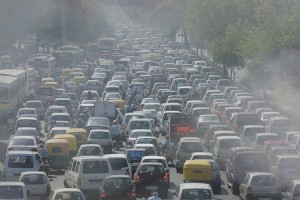The car has been the signifier of the aspiring Indian for decades. Starting in the 1980s, the democratization of car ownership with the explosion in sales of the humble Maruti 800 heralded an emergent middle class.
Every year, governments across the country lay down fresh tar on any available city space to welcome the latest entrants into the coveted league of car owners. Meanwhile, the millions who don’t own cars—and are sidelined to the narrow footpaths that lead to the distant bus stop—continue to aspire to own their own car one day.
The government is now beginning to see why this is a problem. Bengaluru is engulfed in a never-ending traffic jam, Delhi’s pollution is at world-beating levels and Mumbai was never famous for its fast roads. This decade has made it resoundingly clear that the present model of urban transport is unsustainable, and the only way out of the cycle—of rising incomes and more wheels on the road—is an efficient public transport alternative.
In light of this realization, Prime Minister Narendra Modi’s inauguration speech for the Magenta Line of the Delhi Metro was on point. Using a city’s public transport should be a matter of prestige, he said. Modi made a fine attempt to persuade people to choose public transport over private, but persuasion only goes so far. India is stuck in a collective action problem: It’s not rational for anyone to switch to public transport until everyone else also follows. An individual will stop using his car if the bus is faster, but that is possible only if others also get their cars off the road. Unfortunately, city-development plans have failed to create the right incentives, as is borne out by the preference for private transport.
For example, Bengaluru has seen an increase in the number of private vehicles from 2.7 million in 2008 to 6 million in 2017. The growth in roads cannot keep up with this. Meanwhile, roughly half the city’s passenger trips (5 million) are via a fleet of 6,000 Bengaluru Metropolitan Transport Corporation buses.
The urban transport policy must rethink the hierarchy of needs; pedestrians and cyclists must be on top, followed by buses and then motor vehicles.It is absolutely clear that there isn’t enough space for everyone to drive a car, and the government must pivot the policy to delivering reliable public transport. The metro project is a step in the right direction, but it needs complementary changes that improve the citizens’ experience.
Second, the government must resist using attractive-sounding propositions, like pushing electric and hybrid buses, to give the impression that there is the political will to improve urban transport. Changing the fuel of the bus will reduce emissions, but there will be dramatically bigger gains if we are able to prompt even a quarter of the private vehicle-using population to use public transport.
As a positive step towards reforming urban governance, the Centre has proposed incentives worth Rs10,000 crore for meeting certain defined parameters. This should, hopefully, empower municipal bodies, encourage states to delegate more powers to them, and improve the delivery of services. There are other reforms as well, like the lateral entry of officers and giving local bodies greater flexibility in urban planning. However, it remains to be seen whether these reforms will be able to change the conventional ways of the bureaucracy.
India is a growing economy, and census data suggest that only 31% of the population lives in urban centres. Another 300 million people will be added by 2050 and the planning for carrying those people in our cities must begin now. Public transport can easily be the cheaper, faster and economical alternative if policymakers plan for tomorrow’s problems today.
Article source: LiveMint

